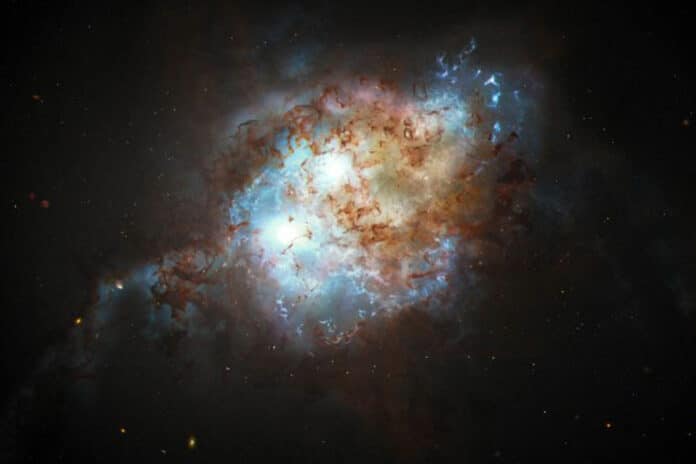Galaxy mergers produce pairs of supermassive black holes (SMBHs), which may be witnessed as dual quasars if both SMBHs are rapidly accreting. The kiloparsec (kpc)-scale separation represents a physical regime sufficiently close for merger-induced effects to be important1 yet wide enough to be directly resolvable with the facilities currently available.
Astronomers in the early universe have discovered two actively feeding supermassive black holes, or quasars, that are only 10,000 light-years apart and on the approach of colliding massively.
Scientists discovered the pair of black holes embedded within two galaxies that merged when the universe was only 3 billion years old by using a variety of space- and ground-based observatories, including two Maunakea Observatories in Hawaii, W. M. Keck Observatory and Gemini North.
Finding such a system is challenging due to the difficulty of telling apart two black holes separately when they are so close to one another. But in this specific system, J0749+2255, both black holes were on a feeding frenzy, gorging on hot gas and dust that had reached such high temperatures that the pair had set off a spectacular fireworks display. When black holes feast, they produce a large amount of light over the electromagnetic spectrum, which is what is known as a quasar.
J0749+2255 is highly unusual because the system has not one, but two quasars that are active simultaneously and are close enough to merge eventually.
Graduate student Yu-Ching Chen of the University of Illinois at Urbana-Champaign, lead author of this study, said, “We don’t see a lot of double quasars at this early time in the universe. And that’s why this discovery is so exciting.”
Following multi-wavelength observations, the researchers determined the double quasar was not two separate quasars caused by gravitational lensing. They did this by using the second-generation Near-Infrared Camera (NIRC2) at Keck Observatory in conjunction with its adaptive optics system, as well as Gemini North, NASA’s Chandra X-ray Observatory, and the Very Large Array network of radio telescopes in New Mexico.
Co-author Yue Shen, an astronomer at the University of Illinois, said, “The confirmation process wasn’t easy, and we needed an array of telescopes covering the spectrum from X-rays to the radio to finally confirm that this system is indeed a pair of quasars, instead of, say, two images of a gravitationally lensed quasar.”
Because telescopes peer into the distant past, this double quasar no longer exists. Their host galaxies have most likely coalesced into a massive elliptical galaxy over the last 10 billion years, similar to those found in our neighborhood. And in its center, a gigantic, supermassive black hole formed from the merger of the quasars.
The massive black hole in the nearby sizeable elliptical galaxy M87 is 6.5 billion times as massive as the Sun. Maybe throughout the last billions of years, one or more galaxies merged to become this black hole.
There is increasing evidence that large galaxies are built up through mergers. Smaller systems come together to form bigger systems and ever-larger structures. During that process, there should be pairs of supermassive black holes formed within the merging galaxies.
Chen said, “Knowing about the progenitor population of black holes will eventually tell us about the emergence of supermassive black holes in the early universe and how frequent those mergers could be.”
Co-author Xin Liu of the University of Illinois at Urbana-Champaign said, “We’re starting to unveil this tip of the iceberg of the early binary quasar population. This is the uniqueness of this study. It is telling us that this population exists, and now we have a method to identify double quasars that are separated by less than the size of a single galaxy.”
Journal Reference:
- Chen, YC., Liu, X., Foord, A. et al. A close quasar pair in a disk–disk galaxy merger at z = 2.17. Nature 616, 45–49 (2023). DOI: 10.1038/s41586-023-05766-6
